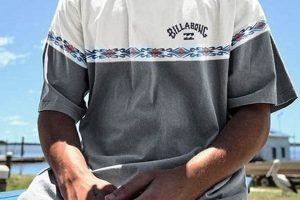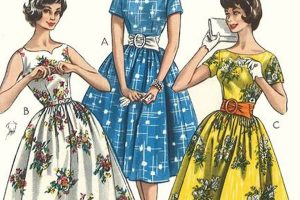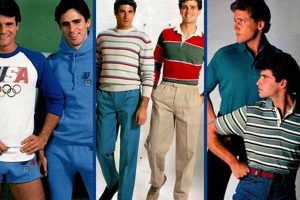Apparel originating from the sixth decade of the twentieth century, often characterized by distinct silhouettes, fabrics, and design aesthetics prevalent during that era, exemplifies a segment of the secondhand market. Examples include A-line dresses, mini skirts, and boldly patterned garments frequently observed in contemporary collections aiming to recapture the spirit of the period.
Retaining garments from that period offers significant advantages, encompassing sustainability through reduced reliance on new manufacturing, preservation of historical textile artistry, and the embodiment of individual style. Garments from that era reflect societal shifts, including evolving attitudes towards youth culture, technological advancements in textile production, and the influence of prominent figures in music, art, and fashion.
Subsequent sections will delve into specific styles, designers, and factors to consider when acquiring pieces from this period. Detailed information on garment care, authentication techniques, and resources for further exploration will also be provided.
Acquiring and Maintaining Garments from the 1960s
The following recommendations are intended to assist in the responsible acquisition, preservation, and enjoyment of apparel originating from the nineteen sixties.
Tip 1: Assess Condition Diligently: Thoroughly inspect prospective acquisitions for damage, including stains, tears, and weakened seams. Consider the cost of restoration against the garment’s intrinsic value.
Tip 2: Verify Authenticity: Research prevalent labels and construction techniques of the period. Compare details against known examples to mitigate the risk of purchasing reproductions misrepresented as originals.
Tip 3: Prioritize Accurate Sizing: Sizing standards differed significantly. Consult size charts specific to the era and consider garment measurements rather than relying solely on labeled size.
Tip 4: Implement Gentle Cleaning Protocols: Many fabrics from this era are delicate. Hand washing or professional dry cleaning, utilizing techniques appropriate for vintage textiles, is recommended.
Tip 5: Employ Correct Storage Methods: Store garments flat or on padded hangers in a cool, dry environment away from direct sunlight to prevent fading and deterioration.
Tip 6: Understand Fabric Composition: Familiarize oneself with the fiber content of the garment to tailor cleaning and storage methods appropriately. Synthetics, natural fibers, and blends each require specific care protocols.
Tip 7: Document Provenance: Preserve any original tags, receipts, or documentation associated with the garment. Such materials enhance its historical value and contribute to its provenance.
Adhering to these guidelines facilitates the responsible stewardship of artifacts reflecting a pivotal period in sartorial history. This approach ensures the prolonged enjoyment and preservation of such items for future generations.
The following sections will explore specific trends and designers that defined the style of this decade in greater detail.
1. Mini Skirts
The miniskirt, a garment characterized by its significantly shortened hemline, represents a pivotal element in the evolution of style. Its emergence during that time period is intrinsically linked to shifting societal norms, the rise of youth culture, and evolving perspectives on female empowerment, solidifying its status as an iconic and representative item.
- Symbol of Youthful Rebellion
The miniskirt directly challenged traditional notions of modesty and feminine attire prevalent in preceding decades. Its adoption by younger generations signified a rejection of established norms and an embrace of self-expression through fashion. Examples include its popularity among young women in London’s Carnaby Street and its association with the “Youthquake” movement.
- Economic and Technological Influences
The economic prosperity of the era contributed to the miniskirt’s accessibility, while advancements in textile manufacturing, particularly the increased availability of affordable synthetic fabrics, facilitated its mass production. This combination of factors enabled wider adoption across various socioeconomic strata.
- Impact on Fashion Industry
The miniskirt’s success prompted designers to explore shorter hemlines and more avant-garde styles, fundamentally altering the trajectory of women’s wear. It also catalyzed the growth of related industries, such as hosiery and legwear, as bare legs became increasingly visible.
- Cultural Significance and Controversy
While celebrated as a symbol of liberation by some, the miniskirt also faced criticism and controversy for its perceived objectification of women. Debates surrounding its appropriateness reflected broader societal tensions related to gender roles and sexuality. Despite such criticism, it remained a powerful symbol of change.
The miniskirt’s enduring legacy underscores its importance within the sphere of apparel from the decade of the nineteen sixties. Its impact extended beyond mere aesthetics, shaping cultural attitudes and influencing subsequent trends in fashion design. Its prevalence within collections of garments from that decade solidifies its position as a defining item.
2. A-Line Silhouettes
The A-line silhouette, characterized by a narrow fit at the shoulders gradually widening towards the hem, emerged as a dominant design element within garments during the nineteen sixties. This stylistic choice reflects a departure from the more structured, form-fitting silhouettes prevalent in the preceding decade, aligning with a broader cultural shift towards youthfulness and modernity. The shape’s inherent simplicity lent itself to diverse applications, appearing in dresses, skirts, and coats, thereby establishing its widespread presence within the spectrum of apparel produced during that time period. Its adoption signifies a deliberate move away from restrictive tailoring, reflecting an emphasis on comfort and ease of movement that resonated with the evolving lifestyles of women during that era. A direct correlation exists between the silhouette’s prominence and the availability of new synthetic fabrics, which facilitated the creation of its clean, uncluttered lines.
Practical applications of the A-line design extended beyond mere aesthetics. Its flattering shape, suitable for a wide range of body types, contributed to its widespread appeal. Garments featuring this silhouette were readily adaptable to various occasions, ranging from casual daytime wear to more formal evening attire, further enhancing their practicality and desirability. Designers frequently incorporated bold geometric patterns, vibrant colors, and innovative embellishments into A-line garments, capitalizing on the silhouette’s inherent versatility to express creativity and reflect the spirit of the period. Examples include shift dresses adorned with Pop Art-inspired prints and mini skirts crafted from synthetic materials in eye-catching hues.
In summary, the A-line silhouette constitutes a crucial component of the garments characteristic of the nineteen sixties. Its association with cultural shifts, technological advancements, and practical design considerations underscores its importance within the history of style. A thorough understanding of this silhouette enhances the appreciation and authentication of vintage pieces from this era, offering valuable insights into the sartorial preferences and societal values of the period. Challenges in preservation may arise due to the delicate nature of certain synthetic fabrics commonly used in A-line garments, requiring specialized cleaning and storage techniques.
3. Bold Geometric Patterns
The prevalence of bold geometric patterns within garments from the nineteen sixties signifies a distinct characteristic of the era’s style. This design element directly reflects the influence of Pop Art, Op Art, and broader cultural trends emphasizing modernity and innovation. The patterns, often featuring vibrant color combinations and sharp, clean lines, marked a departure from the more subdued and organic motifs of previous decades. Their integration into textile design and garment construction solidified them as a recognizable and integral component of garments produced during that time. Examples include dresses featuring oversized polka dots, skirts adorned with tessellating squares, and tops displaying abstract, angular shapes. These patterns conveyed a sense of optimism, forward-thinking design, and youthful exuberance, aligning with the overall cultural climate of the nineteen sixties. The widespread adoption of such patterns directly impacted consumer preferences, driving demand for garments that embodied this aesthetic.
The significance of understanding the connection between bold geometric patterns and garments from this era extends to authentication and historical interpretation. Genuine garments from the period often exhibit specific printing techniques, color palettes, and pattern scales characteristic of nineteen sixties textile production. Recognizing these features aids in distinguishing authentic items from later reproductions or imitations. Furthermore, the patterns themselves provide valuable insight into the cultural influences and artistic movements that shaped the design landscape of the decade. Examination of these textiles allows for a deeper understanding of the interplay between fashion, art, and societal values during this transformative period. Textile manufacturers such as Liberty of London and designers like Emilio Pucci were instrumental in popularizing distinct geometric patterns which became synonymous with garments of the era.
In summary, bold geometric patterns constitute a defining feature of garments produced in the nineteen sixties, reflecting the era’s artistic movements, technological advancements in textile printing, and broader cultural embrace of modernity. The ability to recognize and interpret these patterns is essential for the authentication, preservation, and historical understanding of apparel from that period. Although some reproduction patterns may closely mimic the originals, knowledge of period-specific printing techniques and fabric compositions remains crucial for accurate assessment. The lasting influence of these patterns can be observed in contemporary designs, highlighting their enduring appeal and historical significance.
4. Synthetic Fabric Innovations
The surge in popularity of garments from the nineteen sixties is inextricably linked to concurrent innovations in synthetic fabric production. The introduction of materials such as polyester, nylon, and acrylic revolutionized the apparel industry, offering alternatives to traditional natural fibers. These new synthetics possessed properties including enhanced durability, wrinkle resistance, and ease of care, rendering them highly desirable for mass production and consumer use. The widespread adoption of these fabrics directly influenced the design and availability of a diverse range of garments characteristic of the period. Examples include dresses constructed from brightly colored polyester knits, raincoats crafted from water-resistant nylon, and sweaters fabricated from soft, easy-to-clean acrylic yarns. The affordability of these synthetic materials further democratized fashion, making stylish garments accessible to a wider segment of the population.
The impact of these material advancements extended beyond mere functionality. Synthetic fabrics enabled the creation of garments in bolder colors, more intricate patterns, and innovative silhouettes previously unattainable with natural fibers. The smooth, non-absorbent surfaces of many synthetics served as ideal canvases for the vibrant geometric prints and Op Art designs prevalent in garments of the era. Furthermore, these materials contributed to the development of new construction techniques, such as heat sealing and molding, facilitating the production of seamless garments and structured shapes. Understanding the specific types of synthetic fabrics used in nineteen sixties garments is crucial for proper care and preservation. Certain synthetics are susceptible to degradation from heat, light, or specific chemicals, necessitating specialized cleaning and storage methods.
In summary, the relationship between synthetic fabric innovations and the prevalence of garments from the nineteen sixties is one of mutual influence. These innovations not only expanded the possibilities for garment design and production, but also significantly impacted consumer preferences and accessibility. The correct identification and understanding of these materials remain paramount for the proper preservation and historical appreciation of vintage garments from this era. Challenges in preservation highlight the need for specialized knowledge and careful handling to ensure the longevity of these artifacts of sartorial history. Further research into specific fabric blends and manufacturing techniques employed during the period is encouraged for a more comprehensive understanding.
5. Youthful Rebellion
The cultural phenomenon of youthful rebellion significantly influenced the design and adoption of garments during the nineteen sixties. This era witnessed a marked departure from traditional dress codes, reflecting a broader societal shift towards individual expression and the rejection of established norms. The connection between youthful rebellion and clothing is evident in the styles, fabrics, and overall aesthetic of garments from that time period.
- Rejection of Traditional Silhouettes
Garments from the nineteen sixties often featured shorter hemlines, looser fits, and unconventional shapes that contrasted sharply with the more structured and conservative styles of previous decades. The miniskirt, for example, became a potent symbol of youthful rebellion, challenging established notions of modesty and feminine attire. The adoption of the A-line silhouette and shift dresses further reflected a move away from restrictive tailoring, emphasizing comfort and freedom of movement.
- Embrace of Bold Colors and Patterns
The use of vibrant colors, geometric prints, and psychedelic patterns in nineteen sixties garments reflected a desire for self-expression and a rejection of conformity. These bold design choices served as a visual statement, conveying a sense of optimism, individuality, and a departure from the more subdued color palettes of earlier periods. Pop Art and Op Art movements significantly influenced these patterns, further emphasizing the connection between fashion and cultural rebellion.
- Influence of Music and Counterculture
Musical movements, such as the British Invasion and the rise of rock and roll, profoundly impacted the sartorial choices of young people. Garments inspired by musicians and countercultural figures became increasingly popular, reflecting a desire to align oneself with these influential subcultures. Examples include bell-bottom jeans, tie-dye shirts, and military-inspired jackets, all of which embodied a spirit of rebellion and nonconformity.
- Experimentation with New Materials
The introduction of synthetic fabrics, such as polyester and nylon, facilitated the creation of affordable and easily maintained garments, further contributing to the democratization of style. These materials allowed for greater experimentation with color, texture, and design, enabling the production of garments that were both visually striking and reflective of a youthful, forward-thinking aesthetic.
The styles, patterns, and materials associated with garments from the nineteen sixties are all products of a cultural landscape marked by youthful rebellion. The rejection of traditional norms, the embrace of self-expression, and the influence of music and counterculture all contributed to the distinctive aesthetic of this era. The lasting impact of these trends can still be observed in contemporary fashion, highlighting the enduring power of youthful rebellion to shape sartorial choices.
6. Space Age Influence
The Space Age, initiated by advancements in space exploration during the nineteen sixties, exerted a tangible influence on apparel design. This impact manifested in the adoption of futuristic silhouettes, unconventional materials, and streamlined aesthetics within garments characteristic of the era. The fascination with space travel and technological progress translated into sartorial expressions that reflected a sense of optimism and innovation. Elements such as geometric shapes, metallic accents, and clean, uncluttered lines became prevalent in clothing design, mirroring the sleek and functional aesthetic associated with spacecraft and space-related technologies. The direct consequence was the creation of garments that embodied a forward-thinking vision, diverging from traditional styles and embracing a modern, futuristic sensibility. Examples include Courrges’s Space Age collection featuring mini dresses and angular designs, Paco Rabanne’s use of metal and plastic in garment construction, and Pierre Cardin’s adoption of geometric shapes and synthetic materials in his designs. The inclusion of space-age elements is integral to defining the stylistic identity of the apparel from the era, contributing significantly to its historical and aesthetic value.
The practical application of understanding the Space Age influence extends to the authentication and preservation of artifacts originating from this period. Recognizing design elements inspired by space exploration aids in verifying the authenticity of pieces, distinguishing them from later imitations or reproductions. Knowledge of the materials commonly used in Space Age-inspired apparel, such as synthetic fabrics and metallic embellishments, informs appropriate conservation techniques to mitigate material degradation. Furthermore, comprehending the cultural context surrounding the Space Age enables a more nuanced appreciation of the design choices and aesthetic sensibilities prevalent in apparel from that era. Analyzing the garments through this lens reveals the interplay between technological advancements, artistic expression, and societal aspirations, highlighting the garments’ significance as cultural artifacts reflecting the spirit of innovation and progress.
In summary, the Space Age influence represents a crucial element in understanding and appreciating apparel from the nineteen sixties. Its impact on silhouettes, materials, and design aesthetics resulted in distinctive garments that mirrored the era’s fascination with space exploration and technological advancement. The ability to identify and interpret Space Age design elements enhances authentication efforts, informs conservation strategies, and provides valuable insights into the cultural context surrounding apparel production during this transformative period. Challenges in preservation, particularly related to the degradation of synthetic materials, necessitate ongoing research and specialized conservation techniques to ensure the longevity of these artifacts representing a pivotal moment in both fashion and space exploration history.
Frequently Asked Questions
The following questions and answers address common inquiries regarding garments from the nineteen sixties, providing clarifications on identification, care, and acquisition.
Question 1: How does one distinguish between an authentic garment from the 1960s and a contemporary reproduction?
Authentic pieces typically exhibit construction techniques, fabric compositions, and label styles characteristic of the period. Researching prevalent brands and manufacturing methods of that era is crucial. Examination of seams, closures, and overall detailing often reveals subtle differences between original and replicated items.
Question 2: What are the most common fabrics encountered in garments of the 1960s, and how should they be properly cared for?
Predominant fabrics include synthetics such as polyester, nylon, and acrylic, as well as natural fibers like cotton and wool. Synthetics generally require gentle washing and low-heat drying, while natural fibers may necessitate hand washing or professional dry cleaning. Specific care instructions are dictated by the individual garment’s fabric composition.
Question 3: What factors influence the value of vintage apparel from the 1960s?
Condition, rarity, designer attribution, and historical significance all contribute to the value. Garments in excellent condition, featuring renowned designer labels, or associated with significant cultural events typically command higher prices. Provenance documentation enhances the perceived value.
Question 4: Where are reputable sources for acquiring authentic garments from the 1960s?
Specialized vintage boutiques, established auction houses, and reputable online marketplaces specializing in vintage apparel represent viable sources. Thoroughly vetting sellers and scrutinizing item descriptions is essential prior to purchase. Authentication services offer an additional layer of security.
Question 5: What are the common condition issues encountered in vintage apparel from the 1960s, and are they repairable?
Fading, staining, fabric degradation, and seam stress are frequently observed. The feasibility of repair depends on the severity and nature of the damage, as well as the availability of matching materials and skilled restoration services. Consultation with a professional textile conservator is recommended.
Question 6: How did societal trends and historical events influence garment design during the 1960s?
The decade’s cultural landscape, marked by youthful rebellion, the Space Race, and artistic movements like Pop Art, profoundly impacted apparel design. Shorter hemlines, bold geometric patterns, and the adoption of synthetic materials reflect these influences, mirroring the era’s spirit of innovation and change.
This FAQ provides a foundational understanding of key aspects related to garments originating from the nineteen sixties. Further research and consultation with experts are encouraged for more in-depth knowledge.
The subsequent section will address resources available for further exploration and study.
Conclusion
The preceding analysis has established that 1960s vintage clothing represents a distinct and historically significant category within apparel. The defining characteristics, including unique silhouettes, innovative fabrics, and the influence of sociocultural trends, contribute to its enduring appeal and cultural relevance. Understanding these aspects enables a more informed appreciation, authentication, and preservation of these artifacts.
Continued scholarly examination and responsible stewardship are essential to ensure that garments from this era remain accessible for future study and enjoyment. The lessons learned from analyzing 1960s vintage clothing provide valuable insights into the dynamic relationship between fashion, culture, and technological innovation, underscoring its continued significance in the broader context of sartorial history.







